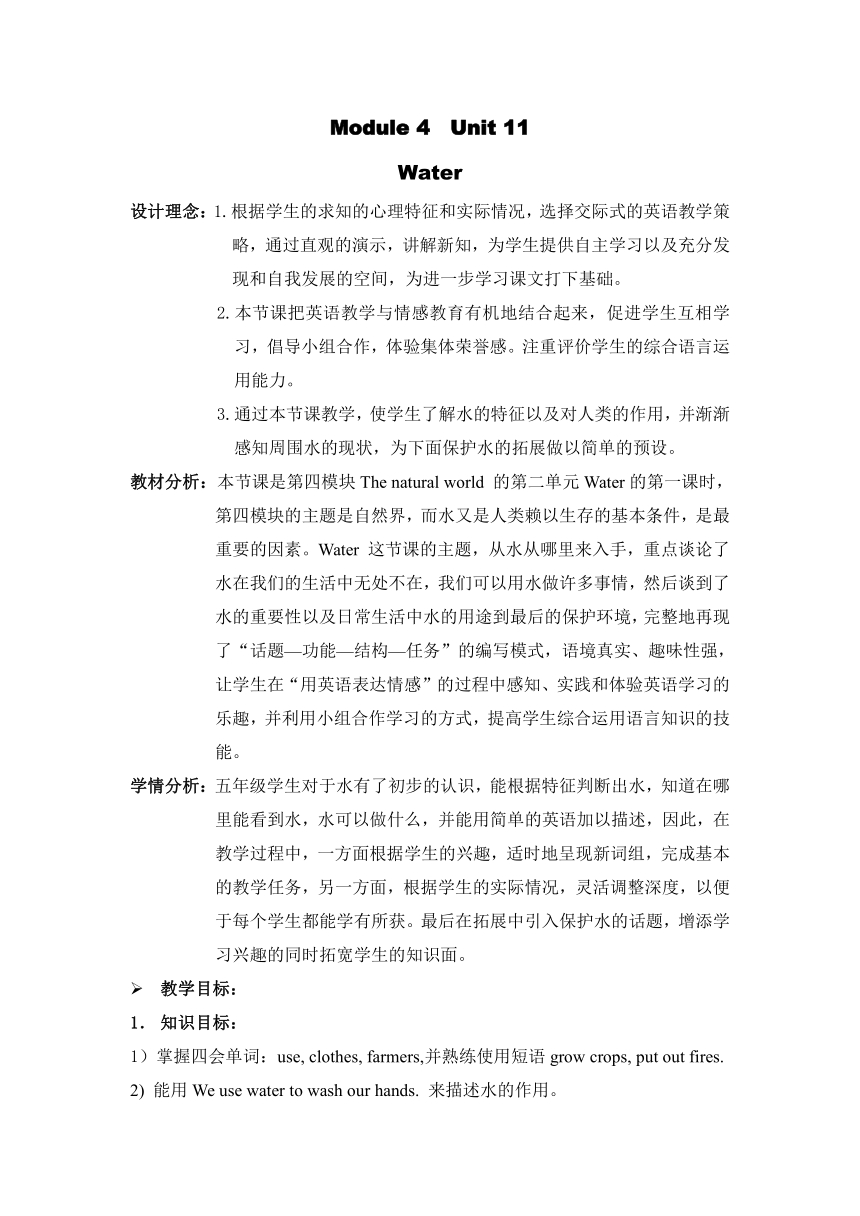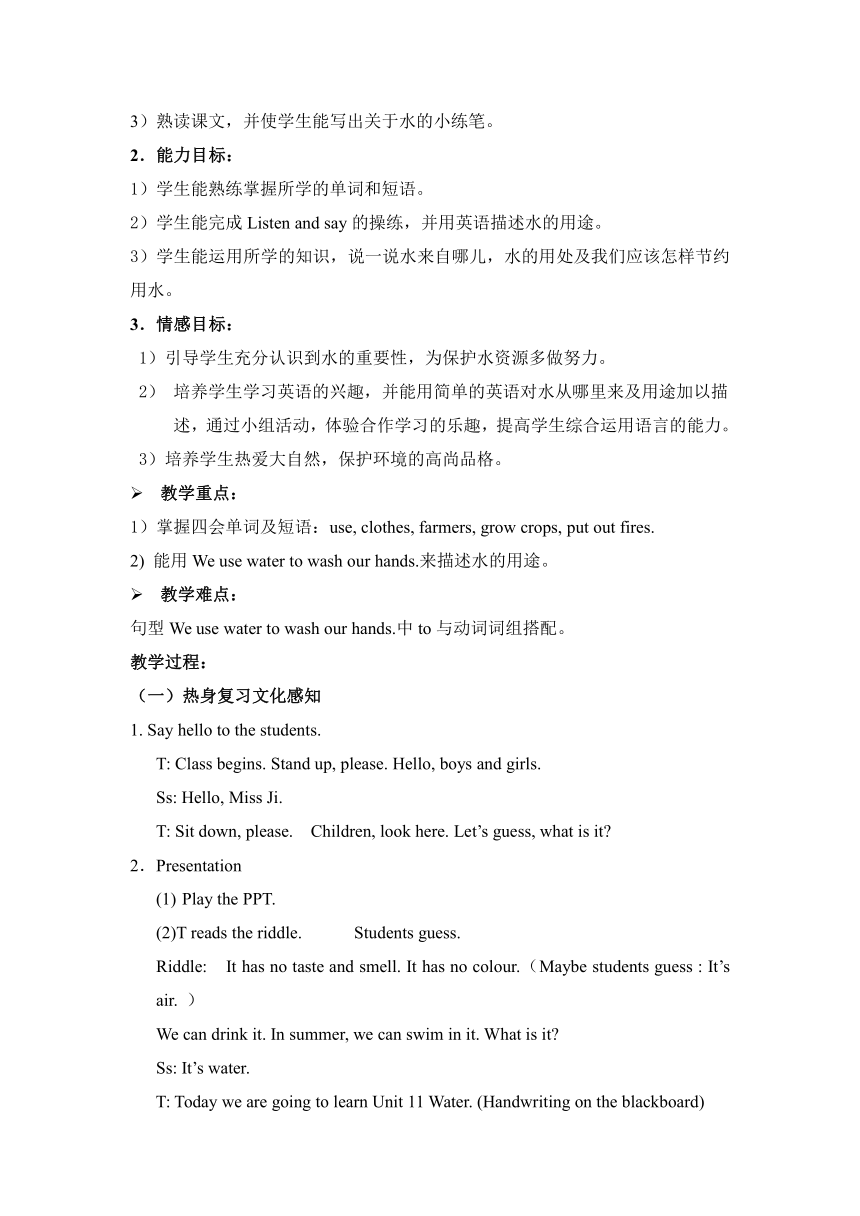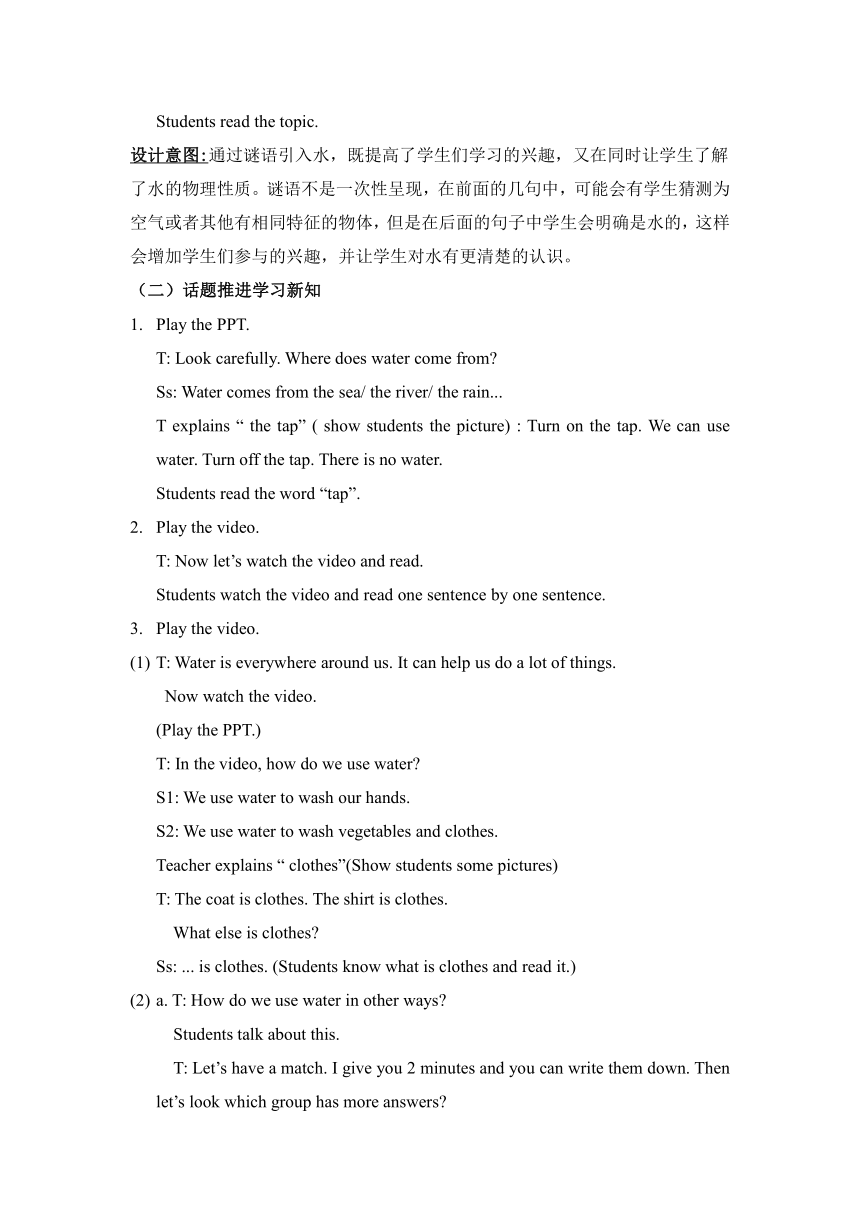Module 4 Unit 11 Water教案
文档属性
| 名称 | Module 4 Unit 11 Water教案 |  | |
| 格式 | doc | ||
| 文件大小 | 81.5KB | ||
| 资源类型 | 教案 | ||
| 版本资源 | 牛津沪教版 | ||
| 科目 | 英语 | ||
| 更新时间 | 2022-11-20 16:23:27 | ||
图片预览



文档简介
Module 4 Unit 11
Water
设计理念:1.根据学生的求知的心理特征和实际情况,选择交际式的英语教学策略,通过直观的演示,讲解新知,为学生提供自主学习以及充分发现和自我发展的空间,为进一步学习课文打下基础。
2.本节课把英语教学与情感教育有机地结合起来,促进学生互相学习,倡导小组合作,体验集体荣誉感。注重评价学生的综合语言运用能力。
3.通过本节课教学,使学生了解水的特征以及对人类的作用,并渐渐感知周围水的现状,为下面保护水的拓展做以简单的预设。
教材分析:本节课是第四模块The natural world 的第二单元Water的第一课时,第四模块的主题是自然界,而水又是人类赖以生存的基本条件,是最重要的因素。Water 这节课的主题,从水从哪里来入手,重点谈论了水在我们的生活中无处不在,我们可以用水做许多事情,然后谈到了水的重要性以及日常生活中水的用途到最后的保护环境,完整地再现了“话题—功能—结构—任务”的编写模式,语境真实、趣味性强,让学生在“用英语表达情感”的过程中感知、实践和体验英语学习的乐趣,并利用小组合作学习的方式,提高学生综合运用语言知识的技能。
学情分析:五年级学生对于水有了初步的认识,能根据特征判断出水,知道在哪里能看到水,水可以做什么,并能用简单的英语加以描述,因此,在教学过程中,一方面根据学生的兴趣,适时地呈现新词组,完成基本的教学任务,另一方面,根据学生的实际情况,灵活调整深度,以便于每个学生都能学有所获。最后在拓展中引入保护水的话题,增添学习兴趣的同时拓宽学生的知识面。
教学目标:
1. 知识目标:
1)掌握四会单词:use, clothes, farmers,并熟练使用短语grow crops, put out fires.
2) 能用We use water to wash our hands. 来描述水的作用。
3)熟读课文,并使学生能写出关于水的小练笔。
2.能力目标:
1)学生能熟练掌握所学的单词和短语。
2)学生能完成Listen and say的操练,并用英语描述水的用途。
3)学生能运用所学的知识,说一说水来自哪儿,水的用处及我们应该怎样节约用水。
3.情感目标:
1)引导学生充分认识到水的重要性,为保护水资源多做努力。
2) 培养学生学习英语的兴趣,并能用简单的英语对水从哪里来及用途加以描述,通过小组活动,体验合作学习的乐趣,提高学生综合运用语言的能力。
3)培养学生热爱大自然,保护环境的高尚品格。
教学重点:
1)掌握四会单词及短语:use, clothes, farmers, grow crops, put out fires.
2) 能用We use water to wash our hands.来描述水的用途。
教学难点:
句型We use water to wash our hands.中to与动词词组搭配。
教学过程:
(1)热身复习文化感知
1. Say hello to the students.
T: Class begins. Stand up, please. Hello, boys and girls.
Ss: Hello, Miss Ji.
T: Sit down, please. Children, look here. Let’s guess, what is it
2. Presentation
(1) Play the PPT.
(2)T reads the riddle. Students guess.
Riddle: It has no taste and smell. It has no colour.(Maybe students guess : It’s air. )
We can drink it. In summer, we can swim in it. What is it
Ss: It’s water.
T: Today we are going to learn Unit 11 Water. (Handwriting on the blackboard)
Students read the topic.
设计意图:通过谜语引入水,既提高了学生们学习的兴趣,又在同时让学生了解了水的物理性质。谜语不是一次性呈现,在前面的几句中,可能会有学生猜测为空气或者其他有相同特征的物体,但是在后面的句子中学生会明确是水的,这样会增加学生们参与的兴趣,并让学生对水有更清楚的认识。
(2)话题推进学习新知
1. Play the PPT.
T: Look carefully. Where does water come from
Ss: Water comes from the sea/ the river/ the rain...
T explains “ the tap” ( show students the picture) : Turn on the tap. We can use water. Turn off the tap. There is no water.
Students read the word “tap”.
2. Play the video.
T: Now let’s watch the video and read.
Students watch the video and read one sentence by one sentence.
3. Play the video.
(1) T: Water is everywhere around us. It can help us do a lot of things.
Now watch the video.
(Play the PPT.)
T: In the video, how do we use water
S1: We use water to wash our hands.
S2: We use water to wash vegetables and clothes.
Teacher explains “ clothes”(Show students some pictures)
T: The coat is clothes. The shirt is clothes.
What else is clothes
Ss: ... is clothes. (Students know what is clothes and read it.)
(2) a. T: How do we use water in other ways
Students talk about this.
T: Let’s have a match. I give you 2 minutes and you can write them down. Then let’s look which group has more answers
Students discuss and write them down. Then they report.
Ss: We use water to clean our teeth/ make drinks...
b.T: Let’s watch the video again. (Play the video again)
Now look here. Please choose the phrases and complete the sentences.
put out fires grow crops
Firemen use water to .
Farmers use water to .
Students choose.
Teacher explains “put out fires ”and “grow crops”.
(Play the PPT)
设计意图:让学生进一步了解“put out fires ”的含义,并且适当拓展知识让学生知道消防员灭火不仅使用水,有时也使用泡沫,增加学生的兴趣。
(1)T: Firemen use water to put out fires. They are brave. Firemen use water to put out fires. They are brave. Sometimes firemen use water to put out fires. Sometimes firemen use powder to put out fires.
设计意图:通过看图和词组排序方式增加学生的兴趣帮助让学生进一步了解“grow crops ”的含义,并且拓展知识让学生知道“water”一词除了有名词“水”的意思,还可做动词意为“浇水”。
(2) Teacher shows students some pictures and words, helps them learn the phrase “ grow crops”.
(3) T:Firemen use water to put out fires. Farmers use water to grow crops. Do you know anything else
Students try to talk about how to use water . (eg. Cook, zoo keeper... )
c. T: We use water at home, in factories … We use it everywhere. (Play the PPT)
Water is useful. Do you know the meaning of useful What else is useful
S1: Air is useful.
S2: Fire is useful.
S3: …
设计意图:通过观看视频以及回答简单问题使学生们初步了解对话内容,为接下来的深入学习做好铺垫。由学生经常接触的话题入手,引入新知,循序渐进,环环相扣,利用PPT辅助教学,为课文学习扫清障碍。
(3)语用实践巩固新知
1. Play the video
T: Now please read the text in your group
students read the text together in group.
2. T: Now please read the conversation in groups of four. Then act it out.
Students practice reading the conversation. Then they act the conversation in groups.
3. T: Look at this exercise. Please fill in the blanks according to the conversation.
Students fill in the blanks and check the answers.
(1) Water comes from , and .
(2) We use water to , , and .
设计意图:归纳梳理全文,巩固新知,通过跟读,练度,分角色朗读等多种形式,巩固课文,加深学生对重点句型的理解和认识。同时,也增加了学生开口说的机会,提高了说的能力。通过学生的小习作,提升学生的语言归纳和综合运用能力,通过相关的小阅读,纵观文章的全局,不断地提升学生的阅读能力
(4)综合拓展激活语言
T: Water is useful. Water is important to us.
But look at these pictures. (Play the PPT )
What is happening
Students look at the PPT.
Ss: NO water.
T: Water is less and less. So we must save water. But some people still waste water. What should we do
Ss: Tell them save water. We can make a poster.
(Play the PPT) Poster
Water comes from .
We use water to .
Water is important to us .
We must save water .
Students try to talk about the poster.
设计意图:通过水资源贫瘠的相关图片,对学生进行环境保护意识的教育,并帮助学生综合运用本课所学内容强化重点句型的使用。
板书设计:
设计意图: 突出本节课的教学重点,描述水的用途,使学生一目了然,有助于学生的记忆和作文的创作,突出本课重点。
Water
设计理念:1.根据学生的求知的心理特征和实际情况,选择交际式的英语教学策略,通过直观的演示,讲解新知,为学生提供自主学习以及充分发现和自我发展的空间,为进一步学习课文打下基础。
2.本节课把英语教学与情感教育有机地结合起来,促进学生互相学习,倡导小组合作,体验集体荣誉感。注重评价学生的综合语言运用能力。
3.通过本节课教学,使学生了解水的特征以及对人类的作用,并渐渐感知周围水的现状,为下面保护水的拓展做以简单的预设。
教材分析:本节课是第四模块The natural world 的第二单元Water的第一课时,第四模块的主题是自然界,而水又是人类赖以生存的基本条件,是最重要的因素。Water 这节课的主题,从水从哪里来入手,重点谈论了水在我们的生活中无处不在,我们可以用水做许多事情,然后谈到了水的重要性以及日常生活中水的用途到最后的保护环境,完整地再现了“话题—功能—结构—任务”的编写模式,语境真实、趣味性强,让学生在“用英语表达情感”的过程中感知、实践和体验英语学习的乐趣,并利用小组合作学习的方式,提高学生综合运用语言知识的技能。
学情分析:五年级学生对于水有了初步的认识,能根据特征判断出水,知道在哪里能看到水,水可以做什么,并能用简单的英语加以描述,因此,在教学过程中,一方面根据学生的兴趣,适时地呈现新词组,完成基本的教学任务,另一方面,根据学生的实际情况,灵活调整深度,以便于每个学生都能学有所获。最后在拓展中引入保护水的话题,增添学习兴趣的同时拓宽学生的知识面。
教学目标:
1. 知识目标:
1)掌握四会单词:use, clothes, farmers,并熟练使用短语grow crops, put out fires.
2) 能用We use water to wash our hands. 来描述水的作用。
3)熟读课文,并使学生能写出关于水的小练笔。
2.能力目标:
1)学生能熟练掌握所学的单词和短语。
2)学生能完成Listen and say的操练,并用英语描述水的用途。
3)学生能运用所学的知识,说一说水来自哪儿,水的用处及我们应该怎样节约用水。
3.情感目标:
1)引导学生充分认识到水的重要性,为保护水资源多做努力。
2) 培养学生学习英语的兴趣,并能用简单的英语对水从哪里来及用途加以描述,通过小组活动,体验合作学习的乐趣,提高学生综合运用语言的能力。
3)培养学生热爱大自然,保护环境的高尚品格。
教学重点:
1)掌握四会单词及短语:use, clothes, farmers, grow crops, put out fires.
2) 能用We use water to wash our hands.来描述水的用途。
教学难点:
句型We use water to wash our hands.中to与动词词组搭配。
教学过程:
(1)热身复习文化感知
1. Say hello to the students.
T: Class begins. Stand up, please. Hello, boys and girls.
Ss: Hello, Miss Ji.
T: Sit down, please. Children, look here. Let’s guess, what is it
2. Presentation
(1) Play the PPT.
(2)T reads the riddle. Students guess.
Riddle: It has no taste and smell. It has no colour.(Maybe students guess : It’s air. )
We can drink it. In summer, we can swim in it. What is it
Ss: It’s water.
T: Today we are going to learn Unit 11 Water. (Handwriting on the blackboard)
Students read the topic.
设计意图:通过谜语引入水,既提高了学生们学习的兴趣,又在同时让学生了解了水的物理性质。谜语不是一次性呈现,在前面的几句中,可能会有学生猜测为空气或者其他有相同特征的物体,但是在后面的句子中学生会明确是水的,这样会增加学生们参与的兴趣,并让学生对水有更清楚的认识。
(2)话题推进学习新知
1. Play the PPT.
T: Look carefully. Where does water come from
Ss: Water comes from the sea/ the river/ the rain...
T explains “ the tap” ( show students the picture) : Turn on the tap. We can use water. Turn off the tap. There is no water.
Students read the word “tap”.
2. Play the video.
T: Now let’s watch the video and read.
Students watch the video and read one sentence by one sentence.
3. Play the video.
(1) T: Water is everywhere around us. It can help us do a lot of things.
Now watch the video.
(Play the PPT.)
T: In the video, how do we use water
S1: We use water to wash our hands.
S2: We use water to wash vegetables and clothes.
Teacher explains “ clothes”(Show students some pictures)
T: The coat is clothes. The shirt is clothes.
What else is clothes
Ss: ... is clothes. (Students know what is clothes and read it.)
(2) a. T: How do we use water in other ways
Students talk about this.
T: Let’s have a match. I give you 2 minutes and you can write them down. Then let’s look which group has more answers
Students discuss and write them down. Then they report.
Ss: We use water to clean our teeth/ make drinks...
b.T: Let’s watch the video again. (Play the video again)
Now look here. Please choose the phrases and complete the sentences.
put out fires grow crops
Firemen use water to .
Farmers use water to .
Students choose.
Teacher explains “put out fires ”and “grow crops”.
(Play the PPT)
设计意图:让学生进一步了解“put out fires ”的含义,并且适当拓展知识让学生知道消防员灭火不仅使用水,有时也使用泡沫,增加学生的兴趣。
(1)T: Firemen use water to put out fires. They are brave. Firemen use water to put out fires. They are brave. Sometimes firemen use water to put out fires. Sometimes firemen use powder to put out fires.
设计意图:通过看图和词组排序方式增加学生的兴趣帮助让学生进一步了解“grow crops ”的含义,并且拓展知识让学生知道“water”一词除了有名词“水”的意思,还可做动词意为“浇水”。
(2) Teacher shows students some pictures and words, helps them learn the phrase “ grow crops”.
(3) T:Firemen use water to put out fires. Farmers use water to grow crops. Do you know anything else
Students try to talk about how to use water . (eg. Cook, zoo keeper... )
c. T: We use water at home, in factories … We use it everywhere. (Play the PPT)
Water is useful. Do you know the meaning of useful What else is useful
S1: Air is useful.
S2: Fire is useful.
S3: …
设计意图:通过观看视频以及回答简单问题使学生们初步了解对话内容,为接下来的深入学习做好铺垫。由学生经常接触的话题入手,引入新知,循序渐进,环环相扣,利用PPT辅助教学,为课文学习扫清障碍。
(3)语用实践巩固新知
1. Play the video
T: Now please read the text in your group
students read the text together in group.
2. T: Now please read the conversation in groups of four. Then act it out.
Students practice reading the conversation. Then they act the conversation in groups.
3. T: Look at this exercise. Please fill in the blanks according to the conversation.
Students fill in the blanks and check the answers.
(1) Water comes from , and .
(2) We use water to , , and .
设计意图:归纳梳理全文,巩固新知,通过跟读,练度,分角色朗读等多种形式,巩固课文,加深学生对重点句型的理解和认识。同时,也增加了学生开口说的机会,提高了说的能力。通过学生的小习作,提升学生的语言归纳和综合运用能力,通过相关的小阅读,纵观文章的全局,不断地提升学生的阅读能力
(4)综合拓展激活语言
T: Water is useful. Water is important to us.
But look at these pictures. (Play the PPT )
What is happening
Students look at the PPT.
Ss: NO water.
T: Water is less and less. So we must save water. But some people still waste water. What should we do
Ss: Tell them save water. We can make a poster.
(Play the PPT) Poster
Water comes from .
We use water to .
Water is important to us .
We must save water .
Students try to talk about the poster.
设计意图:通过水资源贫瘠的相关图片,对学生进行环境保护意识的教育,并帮助学生综合运用本课所学内容强化重点句型的使用。
板书设计:
设计意图: 突出本节课的教学重点,描述水的用途,使学生一目了然,有助于学生的记忆和作文的创作,突出本课重点。
同课章节目录
- Module 1 Getting to know each othe
- Unit 1 My future
- Unit 2 Going to school
- Unit 3 My birthday
- Module 2 Relationships
- Unit 4 Grandparents
- Unit 5 Friends
- Unit 6 Family life
- Module 3 Out and about
- Unit 7 At the beach
- Unit 8 An outing
- Unit 9 Around the city
- Module 4 The natural world
- Unit 10 Wind
- Unit 11 Water
- Unit 12 Fire
